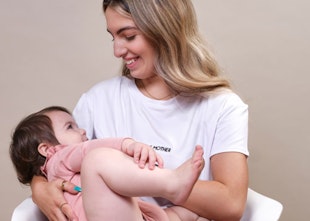Soothers - some parents swear by them, others never warm to them.
Soothers - some parents swear by them, others never warm to them. Regardless, as a new parent, hearing everyone’s opinion on soothers is often confusing.
Deciding whether to give your baby a soother is a personal decision. That said, it is a decision that family, friends and often random strangers, will feel the need to share their opinion on.
It can be very overwhelming trying to figure out the do’s and don'ts when it comes to soothers.
As a speech and language therapist and Mama to two little boys (both of who used soothers by the way), I thought I would lay down some of the facts:
REASONS TO USE A SOOTHER
REASONS TO USE A SOOTHER
- Soothers can give your baby comfort and can help them settle.
- Babies enjoy sucking (some more than others) and will often suck their hands and fingers as young infants. Soothers are easy to control alternative to little fingers and can be taken away at a certain point in a child’s life. Needless to say, taking away fingers and thumbs would prove a little more difficult.
- Research has found a correlation between a reduction in SIDS (Sudden Infant Death Syndrome) and soother use.
- A soother can give comfort when your baby is hurt or sick (e.g. after an injection).
WHEN TO STOP USING A SOOTHER?
By six months, your baby is sucking less and chewing more. Ideally, children shouldn’t be using a soother after 12 months or a bottle with a teet.
REASONS TO STOP USING A SOOTHER AT 12 MONTHS
By six months, your baby is sucking less and chewing more. Ideally, children shouldn’t be using a soother after 12 months or a bottle with a teet.
REASONS TO STOP USING A SOOTHER AT 12 MONTHS
- Using a soother or bottles can give your child less of an opportunity to practice using their lips and tongue for talking. Babbling and practising sounds is a very important part of your child’s cognitive and language development,
- Prolonged soother use can lead to your child having difficulties talking. This may take some time to correct and require speech and language therapy intervention. If your child is learning to speak with a soother in their mouth, their speech sounds can often become distorted. When a child has a soother in their mouth, they do not have full control of the muscles in their mouth used for speech.
- Having a bottle or soother in their mouth can lead to a child not wanting to talk.
- Prolonged bottle/soother use can affect your child’s teeth, causing them to grow out of line and affect the shape of their bite (causing a large gap between the upper and lower teeth). Long term use can actually affect adult teeth too.
TIPS FOR SAYING GOODBYE TO THE SOOTHER
- The younger you stop your child having a soother the easier it will be for both of you. As a child gets older, they develop a moredeep rooted emotional attachment to it, making it more difficult to take away.
- Start by reducing the amount of time in the day your child has the soother. Only use soothers at set times e.g. bedtime. Take the soother once the child is asleep, and do not allow your child use the soother outside of their cot or bed.
- Take your child’s soother out when they are trying to talk or when they are busy playing.
- Once you decide to take away the soother completely, gather up all the soothers in the house and throw them away. This will prevent you or your child finding them in an hour of desperation. In a few days your child will forget about the soother (I know this is hard to believe, but trust me). Remember that giving in when your child cries for it initially will confuse and upset them even more.
- For older children, rewards, praise and using a star chart can be really useful tools.
All I will say is, ripping off the plaster sooner rather than later is your best bet. Once it’s off don’t go trying to stick it back on!
There will be tears, and it will be hard at first. That said, within days, your child will look for it less and less, until they finally forget about it.
As a paediatric speech and language therapist, I see the long term implications of soother use daily in work. I frequently say to parents, the sooner you can rid of the soother, the less likely you will be entering into a long term relationship with me or another speech and language therapist!
Just remember, that using a soother can be a very positive experience for both you and your baby, as long as you follow the guidelines about when to let it go.
Written by Emma O'Leary.
Emma is a mother to two boys and a paediatric speech and language therapist. She can be found blogging at www.lifewithtinyhumans.comabout parenting, motherhood and family life.
Facebook: www.facebook.com/lifewithtinyhumans
Instagram: www.instagram.com/lifewithtinyhumans
Emma is a mother to two boys and a paediatric speech and language therapist. She can be found blogging at www.lifewithtinyhumans.comabout parenting, motherhood and family life.
Facebook: www.facebook.com/lifewithtinyhumans
Instagram: www.instagram.com/lifewithtinyhumans






